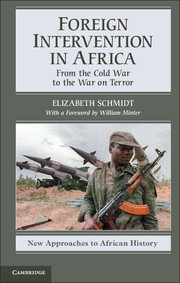Book contents
- Frontmatter
- Contents
- Illustrations
- Acknowledgments
- Foreword
- Abbreviations
- MAP 0.1. Africa, 1947. (Map by Philip Schwartzberg, Meridian Mapping, Minneapolis.)
- MAP 0.2. Africa, 2011. (Map by Philip Schwartzberg, Meridian Mapping, Minneapolis.)
- Introduction
- 1 Nationalism, Decolonization, and the Cold War, 1945–1991
- 2 Egypt and Algeria Radical Nationalism, Nonalignment, and External Intervention in North Africa, 1952–1973
- 3 The Congo Crisis, 1960–1965
- 4 War and Decolonization in Portugal's African Empire, 1961–1975
- 5 White-Minority Rule in Southern Africa, 1960–1990
- 6 Conflict in the Horn, 1952–1993
- 7 France's Private African Domain, 1947–1991
- 8 From the Cold War to the War on Terror, 1991–2010
- Conclusion
- Index
- References
5 - White-Minority Rule in Southern Africa, 1960–1990
Published online by Cambridge University Press: 05 February 2013
- Frontmatter
- Contents
- Illustrations
- Acknowledgments
- Foreword
- Abbreviations
- MAP 0.1. Africa, 1947. (Map by Philip Schwartzberg, Meridian Mapping, Minneapolis.)
- MAP 0.2. Africa, 2011. (Map by Philip Schwartzberg, Meridian Mapping, Minneapolis.)
- Introduction
- 1 Nationalism, Decolonization, and the Cold War, 1945–1991
- 2 Egypt and Algeria Radical Nationalism, Nonalignment, and External Intervention in North Africa, 1952–1973
- 3 The Congo Crisis, 1960–1965
- 4 War and Decolonization in Portugal's African Empire, 1961–1975
- 5 White-Minority Rule in Southern Africa, 1960–1990
- 6 Conflict in the Horn, 1952–1993
- 7 France's Private African Domain, 1947–1991
- 8 From the Cold War to the War on Terror, 1991–2010
- Conclusion
- Index
- References
Summary
In the white-ruled territories of Southern Africa, as elsewhere on the continent, Cold War concerns were superimposed on local struggles emanating from colonial conditions. Colonies with significant settler populations generally rejected the notion of independence and majority rule. As in Algeria, Angola, and Mozambique, white-run governments in the Anglophone territories of South Africa and Southern Rhodesia fought to retain political power and economic privilege in European hands, while South Africa's apartheid regime sought to maintain its illegal occupation of Namibia. To mask the fundamental issue, which was the transfer of power from a privileged white minority to the majority of the population, the settler regimes of Southern Africa employed Cold War rhetoric to garner Western support. Pretoria, especially, played on the threat of a communist onslaught that would consume the last bastion of white Western Christian civilization in Southern Africa.
Despite their public criticism of a system that entrenched racial privilege, the United States and other Western powers generally supported the embattled South African government and shared its concerns about the increasingly radical liberation movements both inside the country and on its borders. Nordic countries were among the few Western nations to provide the African liberation movements with even humanitarian aid. Opposing their governments’ policies, grassroots anti-apartheid and Southern African solidarity movements emerged in the United States and Western Europe. The predominantly African American Council on African Affairs, established in 1937, may have been the first American movement in solidarity with anticolonial and anti-apartheid struggles. The victim of a Cold War era witch hunt, the council dissolved in 1955. Beginning in 1953, the American Committee on Africa brought together civil rights and religious organizations, trade unions, and students to mobilize against colonialism and white-minority rule. A host of other national and local solidarity and anti-apartheid organizations emerged in dozens of countries in the 1960s and 1970s.
- Type
- Chapter
- Information
- Foreign Intervention in AfricaFrom the Cold War to the War on Terror, pp. 102 - 141Publisher: Cambridge University PressPrint publication year: 2013

